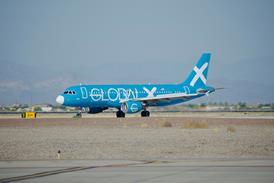US investigators have detailed the confused co-ordination between air traffic controllers that led to a close encounter between an American Airlines Boeing 777 and a pair of US Air Force Boeing C-17s off the New York coast.
The 777 pilots received three resolution advisories from their collision-avoidance system, two ordering a descent and the third demanding a climb, after air traffic control efforts to separate the three aircraft failed.
After a refuelling operation with a McDonnell Douglas KC-10, the westbound C-17s were cleared to descend to 21,000ft (6,400m). Shortly beforehand, the controller had also taken a radar hand-off of the 777, but could not contact its crew because the pilots had not been told to change radio frequency from 128.3MHz.
Before the hand-off the 777, heading southeast, had been cleared to climb to 23,000ft. Unable to reach the 777 himself, the controller sought to halt the climb by asking the 777's previous controller - now busy with a separate flightplan verification - to stop the jet at 20,000ft.
But this request, relayed via an assistant, went unheeded for 46s, and the controller instead ordered the C-17s to turn right in an attempt to increase horizontal separation. He also told the C-17s to stop descending at 22,000ft.
The 777's previous controller, still in radio contact with the jet, overheard the discussion about the C-17s' altitude and mistakenly identified 22,000ft as the height at which to stop the 777's climb.
As a result he ordered the 777 to maintain 22,000ft and also instructed it to turn right as a traffic-avoidance measure.
The C-17s' collision-avoidance systems were operating in "traffic-advisory only" mode, as required by US Air Force multi-ship formation rules, and did not deviate from their altitude, while the 777 crew received three resolution advisories in succession, the third reversing a previously ordered descent.
One of the pilots of the lead C-17 told the controller that it had come "within approximately 2,000ft" of the 777, as the two crossed at the same altitude. The 777 crew transmitted: "That guy passed us now, and that was not good." Radar data indicates the horizontal distance was only 2,300ft and there was no vertical separation. The second C-17 was 500ft to the right and 4,000ft behind the lead.
The controller handling the 777's communications told the crew: "I apologise, I am not working that other airplane." He told the National Transportation Safety Board that the plan to separate the aircraft "was not clearly conveyed to him" and that he was "just guessing what the [other] controller was doing with the [C-17s]", without understanding the "urgency" of the situation.
In a factual disclosure, issued in August, the NTSB attributes the 21 January 2011 encounter, which occurred 88nm (163km) southeast of New York, to a "misunderstanding" between the controllers.
Source: Air Transport Intelligence news




















